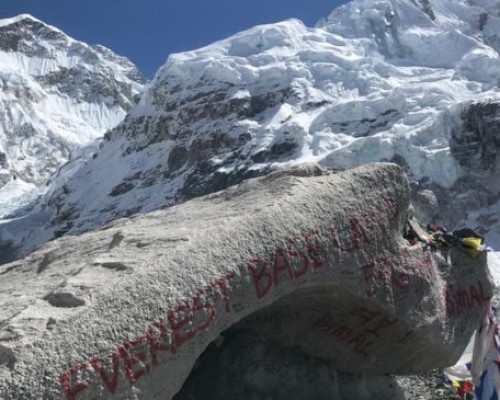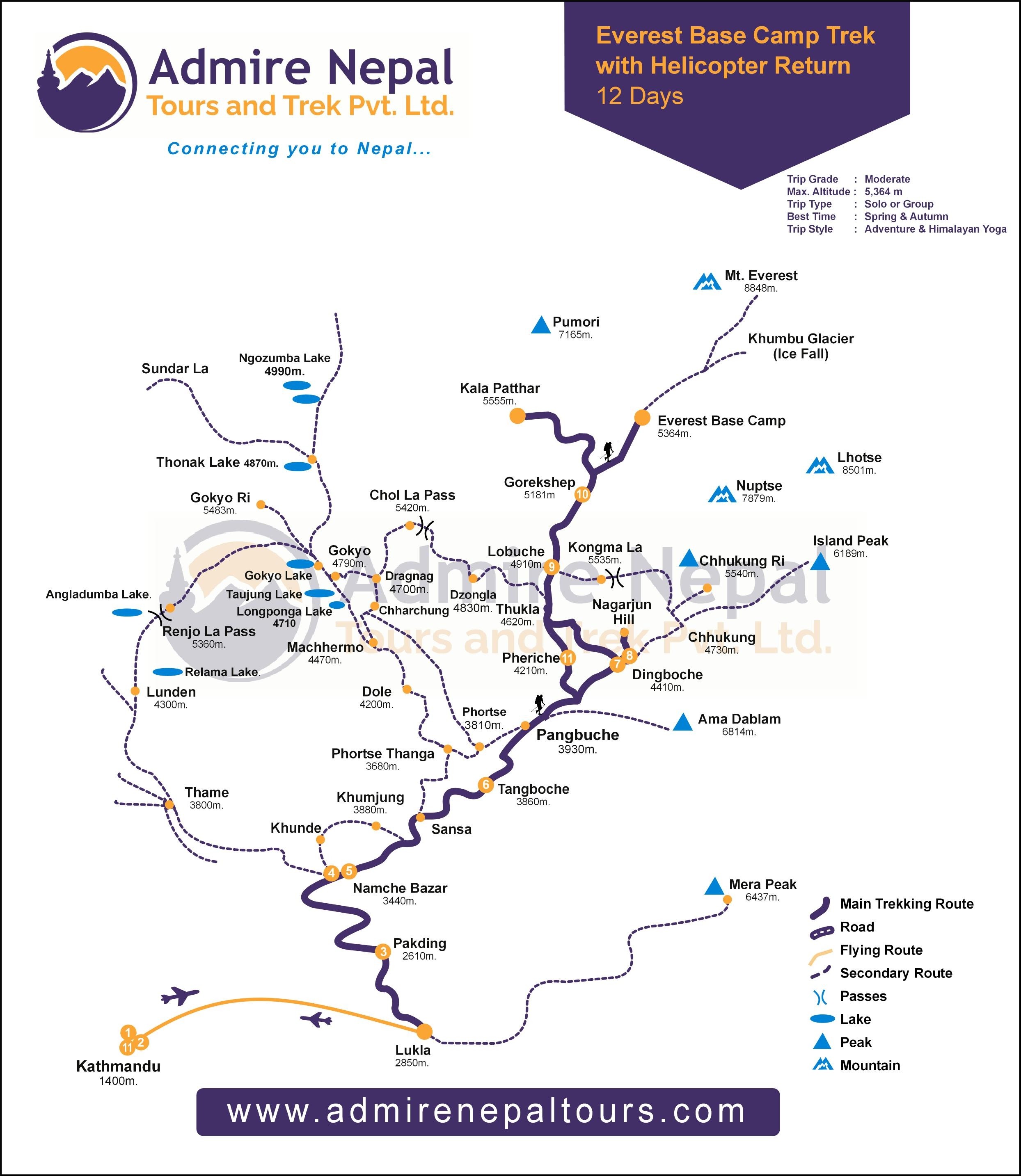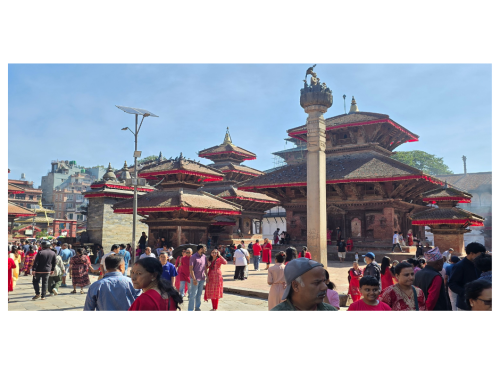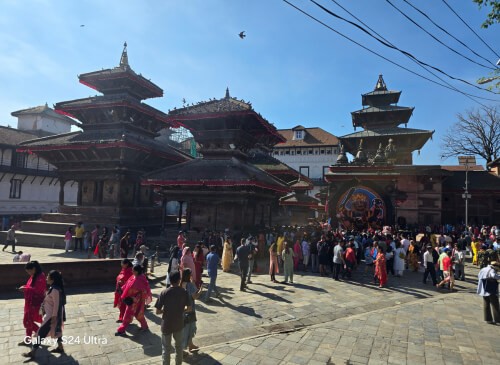“The Everest Base Camp trek with a helicopter return is an exhilarating adventure that takes you to the heart of the Nepalese Himalayas, the northeastern part of the country.”
The venture begins in the bustling city of Kathmandu, where you will spend a day acclimatizing to the altitude and exploring the city's rich culture and history. From Kathmandu, you will take a short flight to Lukla (2,840 m/9,317 ft), where you will begin your trek to Everest Base Camp.
The Everest base camp trek route follows a well-worn trail that winds its way through lush rhododendron & magnolia forests and past picturesque Sherpa villages, offering stunning views of the surrounding mountains. As you gain altitude, the landscape becomes more barren and rugged, with towering peaks and glaciers providing a breathtaking backdrop. You will get to live a unique mountain lifestyle and have a glimpse into the culture of the villagers.
After several days of trekking, you will reach Everest Base Camp, located at an altitude of 5,364 meters (17,598 feet). Here, you will have the opportunity to explore the base camp of the highest mountain in the world, Mt. Everest (8,849 m/29,032 ft), and take in the awe-inspiring views of the Khumbu Icefall and the surrounding peaks. The Everest base camp is packed with colorful tents of mountaineers in the peak season.
Ironically, Mt. Everest is not seen from the Everest base camp because other giant mountains block the views. So, the next day, you'll hike to Kala Patthar (5,644 m/18,517 ft), which is also the highest point of Everest base camp trekking with a helicopter return. Kala Patthar is a famous viewpoint. You will be standing in the clouds at this point, and overpowering views of the Himalayas from here will surely inspire and humble you.
After spending time at the Everest base camp and Kala Patthar, you will begin your journey back to Kathmandu. Rather than retracing your steps, you will take a helicopter ride back to the city. This allows you to avoid the arduous trek back down and gives you the chance to see the mountains from a unique perspective. The aerial views of the Himalayas are to die for. Trust us, you'll not believe your eyes.
Overall, the Everest Base Camp Trek with a helicopter return is a once-in-a-lifetime experience that offers the perfect combination of adventure and luxury. It is a challenging trek that rewards you with incredible views and a true sense of accomplishment. Every second on the trek you will learn, unwind, and rejuvenate. This is one of the best Everest base camp trek packages. The itinerary is short (12 days), so perfect for travelers bound by time.
Everest Base Camp trek with helicopter return difficulty
The Everest Base Camp trek is considered a moderate to difficult trek that requires a fit individual and preparation. The trek involves hiking for several days at high altitudes (5-6 hours a day at minimum), which can be physically demanding. The trail can be rough and uneven in places, and the weather can be unpredictable, with cold temperatures and possible rain or snow.
However, the trek is not considered technical, and no previous mountaineering experience is necessary. The route is well-marked, and there are teahouses & lodges along the way where trekkers can rest and eat. The Everest Base Camp trek with helicopter can be made easier by taking your time, acclimatizing properly, and staying well-hydrated and nourished.
Overall, the difficulty of the Everest Base Camp trek with helicopter return will vary depending on individual fitness levels and the conditions on the trail. It is important to be prepared and to listen to your body to have a safe and enjoyable trek.
Altitude sickness
Altitude sickness, also known as acute mountain sickness (AMS), is a common concern for those who are trekking to high altitudes, such as on the Everest Base Camp trek. AMS occurs when the body is unable to adjust to the lower levels of oxygen at high altitudes, leading to symptoms such as headache, dizziness, nausea, shortness of breath, and fatigue.
Several factors can increase the risk of altitude sickness, including the rate of ascent, the altitude reached, and individual susceptibility. It is important to monitor symptoms and descent if necessary to avoid more severe symptoms, which our mountain guides are experts in.
It is also important to take steps to prevent altitude sicknesses, such as acclimatizing properly, staying hydrated, and avoiding alcohol and other dehydrating substances. Trekkers should also consult with their doctor and follow any recommended precautions before embarking on the trek.
Our 12 days Everest base camp trek with helicopter return itinerary let trekkers acclimatize properly during the trek. We have ample acclimatization days and side hikes. Moreover, our guide ensures the safety of the trekkers by regularly checking their health conditions in the mountains.
Everest base camp trek with helicopter return preparation
There are several important steps you should take to prepare for the Everest Base Camp trekking.
These include:
Get in shape: The Everest Base Camp trek is a physically demanding trek that requires a good level of fitness. Before embarking on the trek, it is important to get in shape by doing regular cardiovascular and strength training exercises. This will help you to cope with the demands of the trek and reduce the risk of injury.
Consult with your doctor: It is important to consult with your doctor before embarking on the trek, especially if you have any existing medical conditions. Your doctor can provide advice on any precautions you should take and can recommend any necessary medications.
Get the necessary gear: Everest Base Camp trekking with helicopter return explores a challenging environment, so it is important to have the right gear. This includes proper hiking boots, warm and waterproof clothing, a good quality sleeping bag, and other essentials. It is also important to have a good-quality backpack to carry all of your gear.
Best Everest Base Camp trek with helicopter return 2026
We have the best Everest base camp trek with helicopter return given our short itinerary, price, and services offered at low cost. You will be guided by a professional mountain guide and porters. Likewise, our management team will make sure all the permits and reservations are done on time for a smooth venture. You do not have to worry about anything while doing Everest base camp helicopter trek with us, Admire Nepal Tours.
To book the Everest base camp trek with helicopter return 2026 spring or autumn departure, send us your inquiry now. It is a perfect adventurous trek for everyone, friends, couples, family, colleagues, etc. We offer great discounts on big groups with assistant guides.
You can do the classic Everest base camp trek with us if you do not prefer to fly in a helicopter. Luxury Everest base camp trek also offers a great trekking experience. Travelers who do not have time to go on a long trek can join our Everest base camp helicopter tour. It is a 4-5 hours tour with multiple landings and happens in the morning.





